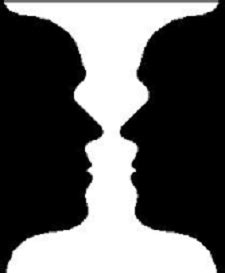Introduction
Our brains are constantly bombarded with information from our environment. One of the most important ways we make sense of this information is through figure-ground perception. Figure-ground perception is the ability to distinguish between an object (the figure) and its background (the ground).

How Figure-Ground Perception Works
Figure-ground perception is a complex process that involves many different factors, including:
- Proximity: Objects that are close together are more likely to be perceived as a figure than objects that are far apart.
- Similarity: Objects that are similar in shape or color are more likely to be perceived as a figure than objects that are different.
- Symmetry: Objects that are symmetrical are more likely to be perceived as a figure than objects that are asymmetrical.
- Closure: We tend to fill in the gaps in our perception and see objects as complete even when they are not.
- Past experience: Our past experiences can influence how we perceive figure-ground relationships.
Applications of Figure-Ground Perception
Figure-ground perception has a wide range of applications in everyday life, including:
- Art: Artists use figure-ground relationships to create depth and perspective in their work.
- Design: Designers use figure-ground relationships to make products more user-friendly and visually appealing.
- Marketing: Marketers use figure-ground relationships to make their advertisements more effective.
- Psychology: Psychologists use figure-ground perception to study how people perceive the world around them.
Disorders of Figure-Ground Perception
In some cases, people may experience disorders of figure-ground perception. These disorders can make it difficult to distinguish between objects and their backgrounds. Disorders of figure-ground perception can be caused by a variety of factors, including:
- Brain damage: Damage to the brain can disrupt the neural pathways that are involved in figure-ground perception.
- Mental illness: Some mental illnesses, such as schizophrenia, can cause disturbances in figure-ground perception.
- Drugs and alcohol: Drugs and alcohol can temporarily impair figure-ground perception.
Conclusion
Figure-ground perception is a fundamental part of human cognition. It allows us to make sense of our environment and interact with the world around us. Disorders of figure-ground perception can have a significant impact on a person’s life, making it difficult to perform everyday tasks and participate in social activities.
Table 1: Factors that Influence Figure-Ground Perception
| Factor | Description |
|---|---|
| Proximity | Objects that are close together are more likely to be perceived as a figure than objects that are far apart. |
| Similarity | Objects that are similar in shape or color are more likely to be perceived as a figure than objects that are different. |
| Symmetry | Objects that are symmetrical are more likely to be perceived as a figure than objects that are asymmetrical. |
| Closure | We tend to fill in the gaps in our perception and see objects as complete even when they are not. |
| Past experience | Our past experiences can influence how we perceive figure-ground relationships. |
Table 2: Applications of Figure-Ground Perception
| Application | Description |
|---|---|
| Art | Artists use figure-ground relationships to create depth and perspective in their work. |
| Design | Designers use figure-ground relationships to make products more user-friendly and visually appealing. |
| Marketing | Marketers use figure-ground relationships to make their advertisements more effective. |
| Psychology | Psychologists use figure-ground perception to study how people perceive the world around them. |
Table 3: Disorders of Figure-Ground Perception
| Disorder | Description |
|---|---|
| Brain damage | Damage to the brain can disrupt the neural pathways that are involved in figure-ground perception. |
| Mental illness | Some mental illnesses, such as schizophrenia, can cause disturbances in figure-ground perception. |
| Drugs and alcohol | Drugs and alcohol can temporarily impair figure-ground perception. |
Table 4: Tips for Improving Figure-Ground Perception
| Tip | Description |
|---|---|
| Pay attention to the details | When you are looking at an object, pay attention to the specific details of the object, such as its shape, color, and texture. |
| Use context | Use the context of the situation to help you figure out what an object is. For example, if you see a white object in a glass of milk, you are more likely to perceive it as a spoon than a ball. |
| Be aware of your biases | Be aware of your own biases and how they might influence your perception of figure-ground relationships. For example, if you are expecting to see a certain object, you are more likely to perceive it as a figure. |
